




TOD'S MILL
The River Avon, forming part of the western boundary of West Lothian, has been the power source for many mills over the years.
In the Statistical Accounts for 1796, the Rev. Mr Robert Rennie tells us ....
On the River Avon, which skirts the parish on the south and west, there are five mills, the property of the Duke of Hamilton. To the 2
corn-mills, all the barony of Kinniel are thirled with their oats, and pay as dues the 17th part or peck. Farmers from other parishes, pay
only the half of this multure. There are 2 flour mills, which grind flour for Falkirk, Borrowstownness, &c. The fifth mill was built for the
purpose of grinding malt, for the brewers in Borrowstownness; but is employed at present, in grinding flint for the pottery in
Borrowstownness. The River Avon is a fine stream, well fitted for the purposes of machinery. Falls of considerable height may be
found; and there is plenty of water, unless when the drought of summer is uncommonly severe. The water is also perfectly pure, except
when the torrents rush impetuous from the hills, after heavy rain.
The fifth mill was Tod's Mill and stood near Birkhill (Birchhill in those days).
Before they are ground, flintstones have to be calcined (oxidised) and this process was done in kilns that had been built next to the mill.
Flint was imported from Gravesend in Kent. Powdered flint formed part of the clay mixture and it prevented deformation of the pots
during drying and firing.
Although the Statistical Accounts tell us the mill was grinding flints in the late 18th century, the first census in 1841 gives no indication
as to the nature of the mill.
|
1841 CENSUS
|
||||
|
TODS MILL
|
||||
|
Name
|
Age
|
Sex
|
Occupation
|
Where Born
|
|
Sarah Thomson
|
50
|
F
|
Independent
|
West Lothian
|
|
James Galbreath
|
15
|
M
|
Male Servant
|
West Lothian
|
|
BIRCHHILL
|
||||
|
Alexander Monteath
|
50
|
M
|
Farm Servant
|
West Lothian
|
|
Hugh Monteath
|
20
|
M
|
Mill Wright
|
West Lothian
|
|
James Glass
|
2
|
M
|
---
|
West Lothian
|
Ten years later, one of the occupants is a Flint Miller.
|
1851 CENSUS
|
||||
|
TOD'S MILL
|
||||
|
Name
|
Age
|
Sex
|
Occupation
|
Where Born
|
|
Sarah Thomson
|
60
|
F
|
Housekeeper
|
Bo'ness
|
|
James Galbraith
|
25
|
M
|
Flint Miller
|
Bo'ness
|
After purchasing the Bo'ness Pottery in 1855, John Marshall built additional kilns. Some of these kilns were obviously flint kilns
because the 1861 census shows a change of use for Tod's Mill.
Some years later, the Courier ran an article on Bo'ness Pottery and it tells us .....
Flint is an indispensible commodity which must be properly ground and mixed with the clay. For this purpose Messrs. Marshall & Co.,
have kilns of their own on hand at their premises for burning the flint. These kilns are somewhat similar to these used for burning
limestone. After the flint has been burnt it is ground and converted into a fine solution in four large vats by means of an engine 63 horse
power.
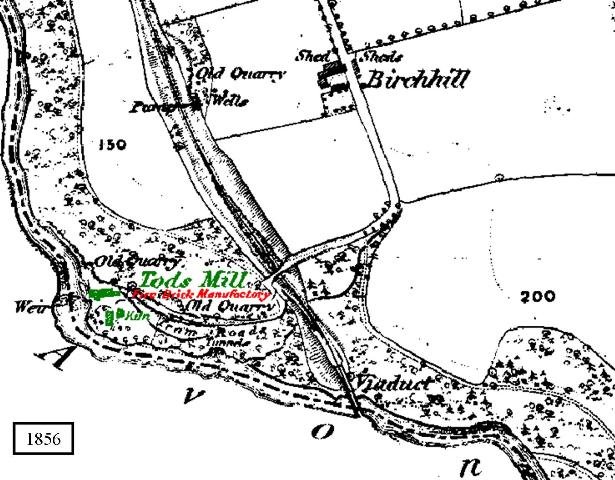
This ordnance map from 1856 shows a kiln and Fire Brick Manufactory and in the 1861 Census there was a Brickmaker lodging at
Todsmill but no Flint Miller.
|
1861 CENSUS
|
||||
|
TODSMILL
|
||||
|
Name
|
Relation to Head of Family
|
Age
|
Occupation
|
Where Born
|
|
James Frew
|
Head
|
40
|
Miner
|
Calder
|
|
Mary Frew
|
Wife
|
39
|
---
|
Kirkintilloch
|
|
Margaret Frew
|
Daughter
|
13
|
---
|
Kirkintilloch
|
|
Mary Frew
|
Daughter
|
6
|
---
|
Kirkintilloch
|
|
James Frew
|
Son
|
2
|
---
|
Muiravonside
|
|
William Gilmour
|
Lodger
|
39
|
Brickmaker
|
Muirkirk
|
This 1867 advert from Slaters Directory shows the change in the manufacturing process at the mill.
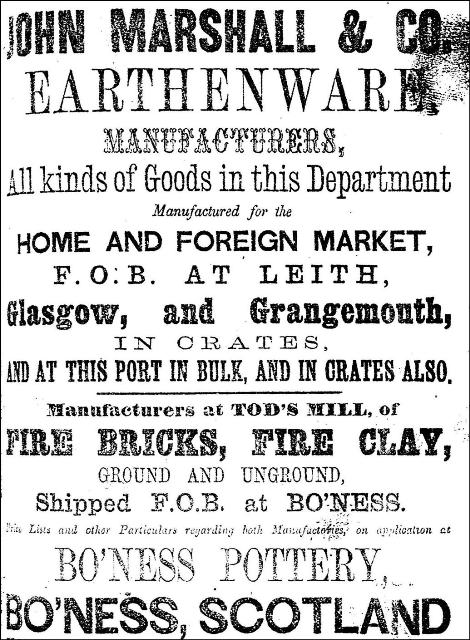
In 1871, there is no mention of brickmaking but it would appear that the property was still owned by the pottery.
|
1871 CENSUS
|
||||
|
TODD'S MILL
|
||||
|
Name
|
Relation to Head of Family
|
Age
|
Occupation
|
Where Born
|
|
James Newbigging
|
Head
|
37
|
Glaze Miller for Pottery
|
Broughton
|
|
Christina Newbigging
|
Wife
|
35
|
---
|
Bo'ness
|
|
John Newbigging
|
Son
|
14
|
Labourer
|
Carriden
|
|
Julia Newbigging
|
Daughter
|
12
|
Scholar
|
Carriden
|
|
Barbara Newbigging
|
Daughter
|
9
|
Scholar
|
Carriden
|
|
Anne Newbigging
|
Daughter
|
7
|
Scholar
|
Carriden
|
|
Alexander Newbigging
|
Son
|
4
|
---
|
Carriden
|
|
Robert Newbigging
|
Son
|
2
|
---
|
Carriden
|
|
TODD'S MILL - COTTAGE
|
||||
|
Robert Robertson
|
Head
|
53
|
Limestone Merchant
|
Hamilton
|
|
Grace Robertson
|
Wife
|
52
|
---
|
Douglas
|
|
John West
|
Grand Son
|
4
|
---
|
Linlithgow
|
The 1871 Census is the last census to suggest any connection with Bo'ness Pottery.
The mill is sited in a wooded area very close to the Bo'ness - Manuel railway line and this appears to have influenced who the future
occupants would be.
|
1881 CENSUS
|
||||
|
TODS MILL
|
||||
|
Name
|
Relation to Head of Family
|
Age
|
Occupation
|
Where Born
|
|
John Stuart
|
Head
|
24
|
Wood Forester
|
Abernethy
|
|
TODS MILL
|
||||
|
Stewart Macaulay
|
Head
|
24
|
Railway Platelayer
|
Linlithgow
|
|
Bridget Macaulay
|
Wife
|
25
|
---
|
Ireland
|
|
Donald Macaulay
|
Son
|
2
|
---
|
Bo'ness
|
|
Thomas Macaulay
|
Son
|
1
|
---
|
Bo'ness
|
|
1891 CENSUS
|
||||
|
TODS MILL
|
||||
|
Name
|
Relation to Head of Family
|
Age
|
Occupation
|
Where Born
|
|
Charles Liddle
|
Head
|
33
|
Forester
|
Bo'ness
|
|
Margaret Liddle
|
Wife
|
31
|
---
|
Redding
|
|
Robert Liddle
|
Son
|
8
|
Scholar
|
Bo'ness
|
|
John Liddle
|
Son
|
7
|
Scholar
|
Bo'ness
|
|
Charles Liddle
|
Son
|
2
|
---
|
Bo'ness
|
|
Margaret Liddle
|
Daughter
|
5
|
Scholar
|
Bo'ness
|
|
Agnes Liddle
|
Mother
|
66
|
---
|
Bo'ness
|
|
TODS MILL
|
||||
|
Stewart Macaulay
|
Head
|
34
|
Railway Surfaceman
|
Linlithgow
|
|
Bridget Macaulay
|
Wife
|
31
|
---
|
Ireland
|
|
Donald Macaulay
|
Son
|
12
|
Scholar
|
Bo'ness
|
|
Thomas Macaulay
|
Son
|
11
|
Scholar
|
Bo'ness
|
|
Mary Macaulay
|
Daughter
|
9
|
Scholar
|
Abercorn
|
|
Stewart Macaulay
|
Son
|
2
|
---
|
Bo'ness
|
|
Catherine Derrick
|
Visitor
|
13
|
Scholar
|
Linlithgow
|
|
Agnes Derrick
|
Visitor
|
11
|
Scholar
|
Bo'ness
|
|
Janet Macaulay
|
Daughter
|
1
|
---
|
---
|
|
1901 CENSUS
|
||||
|
TODS MILL
|
||||
|
Name
|
Relation to Head of Family
|
Age
|
Occupation
|
Where Born
|
|
Charles Liddle
|
Head
|
44
|
Assistant Forester
|
Bo'ness
|
|
Margaret Liddle
|
Wife
|
42
|
---
|
Redding
|
|
Robert Liddle
|
Son
|
18
|
Engine Fireman
|
Bo'ness
|
|
John Liddle
|
Son
|
17
|
Engine Cleaner
|
Bo'ness
|
|
Margaret Liddle
|
Daughter
|
15
|
Home Assistant
|
Bo'ness
|
|
TODS MILL
|
||||
|
Stewart Macaulay
|
Head
|
44
|
Railway Surfaceman
|
Linlithgow
|
|
Bridget Macaulay
|
Wife
|
41
|
Hawker
|
Ireland
|
|
Donald Macaulay
|
Son
|
22
|
Locomotive Fireman
|
Bo'ness
|
|
Thomas Macaulay
|
Son
|
21
|
Locomotive Fireman
|
Bo'ness
|
|
Mary Macaulay
|
Daughter
|
19
|
Dressmaker
|
Abercorn
|
|
Stewart Macaulay
|
Son
|
12
|
Scholar
|
Bo'ness
|
|
Janet Macaulay
|
Daughter
|
11
|
Scholar
|
Bo'ness
|
|
Agnes Derrick
|
Visitor
|
21
|
Servant
|
Linlithgow
|
Bo'ness Pottery closed in 1899 so even if it had retained ownership of the mill when it was no longer occupied by its employees, all
connections would had been severed by 1901.

This is a piece of flint found at Tod's Mill. According to geologists who examined the flint, the white areas are chalk deposits.
They concluded that as chalk is not natural to the area this piece of flint is not local and therefore had been brought in to the area.
This is a piece of flint that managed to avoid the kiln and millstones.
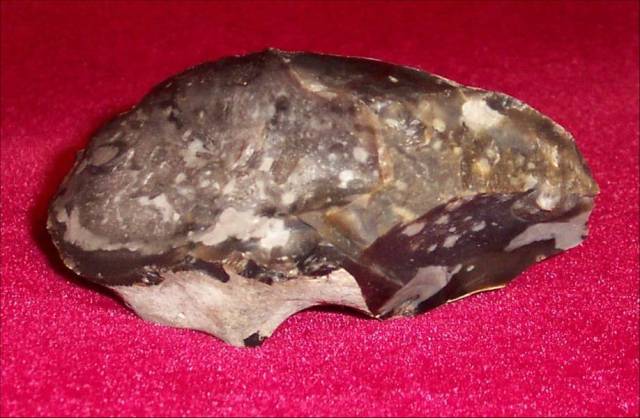
TOD'S MILL GALLERY
Date unknown
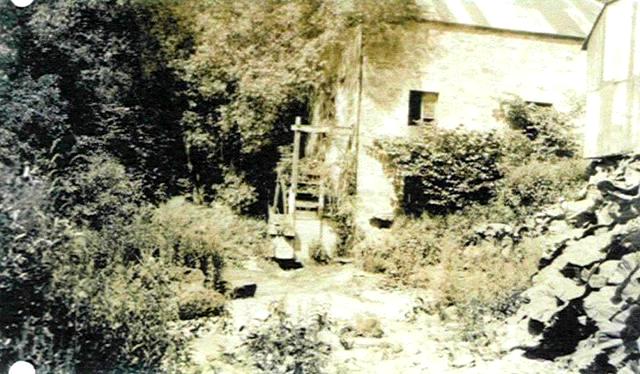
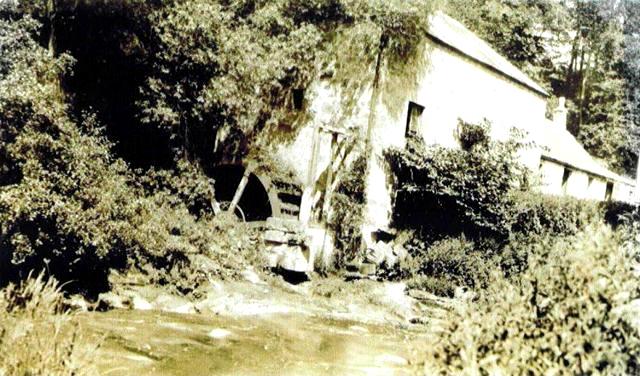
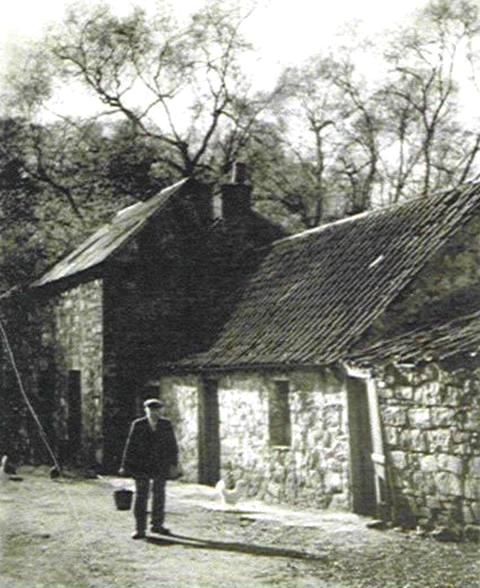
2002 ~~~~~~~~~~~~~~~~~~~~~~~~~~~~~~~~~~~~~~~~~~~~~~~~~~~~~~~~~~~~~~~~~~~~~~~~~~~~~~~ 2002
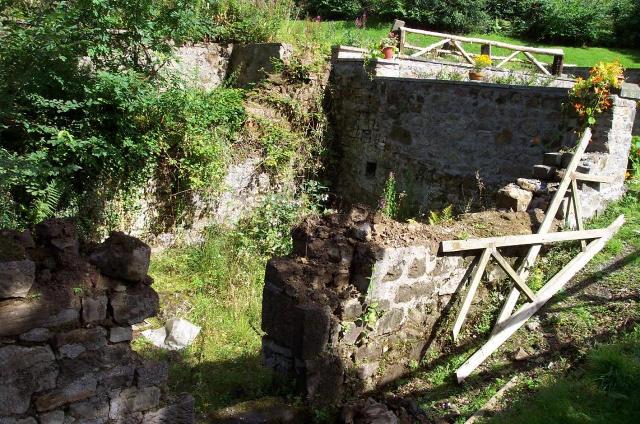
The following photos taken in 2002 are the ruined remains of the buildings in the photos above. The inner rim of the mill wheel is still
attached to the wall, the only indication of the building's industrial past.
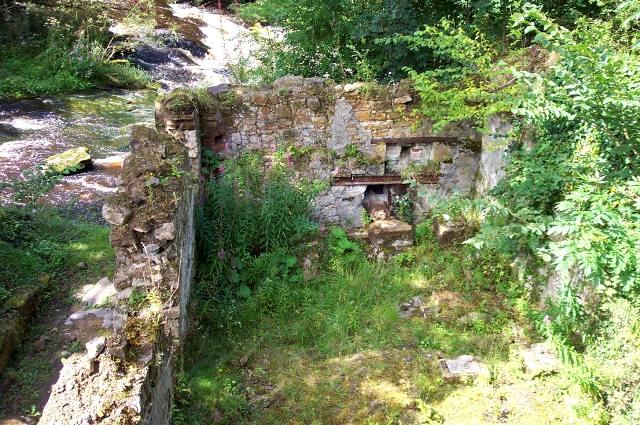


2009 ~~~~~~~~~~~~~~~~~~~~~~~~~~~~~~~~~~~~~~~~~~~~~~~~~~~~~~~~~~~~~~~~~~~~~~~~~~~~~~~ 2009
Following an ambitious building project by the mill site's owner, the following building has risen from the ruins above. The mill wheel
has been restored after the outer rim was recovered from the silt and perhaps one day it will turn again. The building was completed
in 2006 and is available to rent as a holiday cottage. Tod's Mill is no more, it has been renamed
The Wheelhouse
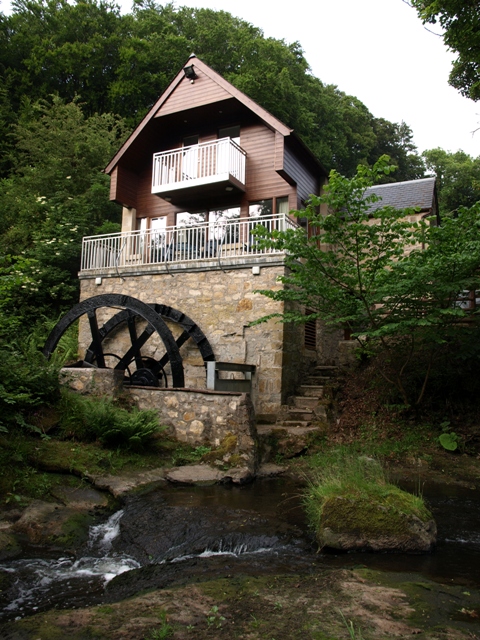

The two rods showing above the water's surface (above) were part of the original dam that directed the river towards the wheel.
After turning the wheel, the water re-entered the river by the channel below.
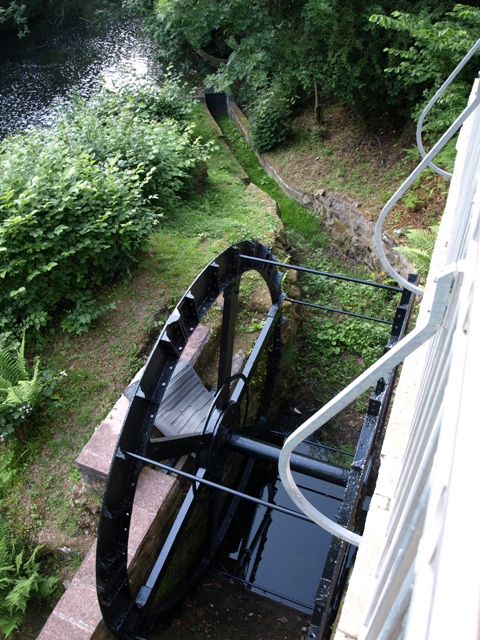
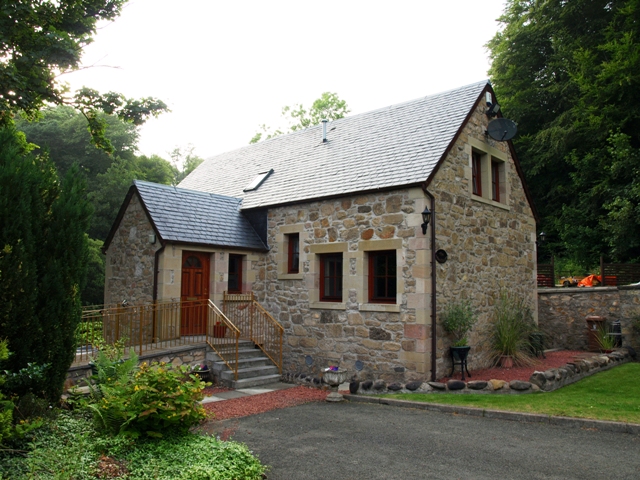
The new entrance to the mill building

The mill from the other side

In the 1871 Census, a second house appeared in the Tod's Mill entry. This is it.

Fifty years ago, a tall chimney (possibly from the brickmaking era) was standing where the shrubbery on the lawn is now.
That was Tod's Mill, but who was Tod?
To be continued (hopefully) .....